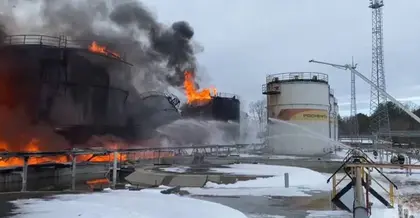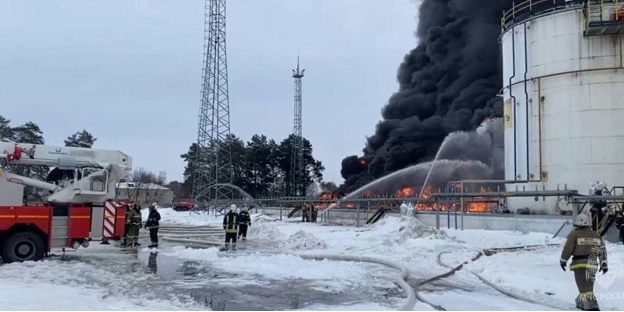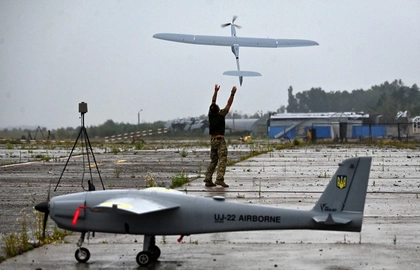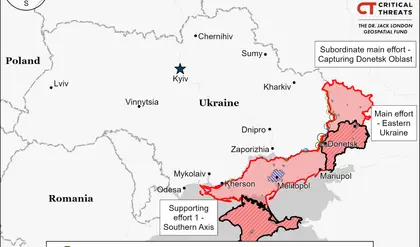Of the waves of drone attacks that kicked off a new Ukrainian strategy to target energy and military infrastructure inside Russia, probably the most impressive, thus far has been in Klintsy
On Wednesday at around 9p.m. the residents of the usually-quiet border town of Klintsy, in Russia’s western Bryansk Oblast, saw flashes in the night sky.
Local officials quickly announced that drones, launched by “Ukrainian terrorists,” had flown across the international frontier some 20 kilometers to the south, but said there was no danger to Russia and Russians because the Ukrainian aircraft had been successfully jammed or destroyed by Russian air defenses.
The citizens of Klintsy need not be concerned, those official statements continued, because no one was hurt, Russian air defenses are strong, and certainly there was no damage to anything.
Two days later, shortly after 7:40 a.m. users of social media in Klintsy started furiously exchanging messages about how the town’s “oil depot” was burning – and that the fire was anything but small. Images posted on local Telegram channels, geo-located by Kyiv Post, showed a massive blaze in a fuel storage facility operated by Russia’s Rosneft.
The first official Kremlin acknowledgement was relatively upbeat, as the Russian Ministry of Defense announced “a single Ukrainian drone” had been shot down by Kremlin air defense units. The report did not make reference to any damage or fire.
As the sun came up, local media users began posting images of the Rosneft depot burning fiercely with 50-meter-high orange flames and black, oily smoke clouds billowing into the clear, blue winter sky visible from kilometers away.
Defense Ministry spokesmen continued to advance the narrative that a single Ukrainian drone had been knocked down by jamming, causing a small fire when it released an explosive device. Teams from Russia’s Ministry of Emergency Situations were on the scene with fire trucks and had the flames under control, the official statements said.
Some Klintsy residents, declaring a disconnect between what Moscow was saying and what they could see from their apartment windows, continued to post comment and images of the blaze. This was in direct violation of Russian laws that ban the unsanctioned placing of images on social or mainstream media that show the results of Ukrainian strikes on Russian territory.
“It’s getting bigger!”, “Horrible!” and “This is Klintsy right now!” read some of the captions under posted photographs of the burning depot.
Kremlin attempts to suppress the content that confirmed a successful Ukrainian attack were complicated by the oil depot being located in a city of 63,000, and adjacent to a main railway line.
Hundreds of travelers arriving at or passing through Klintsy were met with real life images of oily smoke sweeping across train tracks. By midday, authorities had to admit that the fire wasn’t “yet fully under control” and that a “fire train” was en-route to reinforce the firefighters.
Subsequent reports backed by hundreds of images confirmed four oil storage tanks were burning fiercely, one of which had appeared to have exploded, and that there were at least five more multi-ton fuel containers only meters from the flames.
Official statements changed from a narrative of controllable fire to a serious fire set off by a single Ukrainian drone that had, although shot down, managed to drop explosives that, in an unfortunate turn of events for Russia, had touched off the oil base bonfire. By evening video of the moment that the explosion took place appeared on Russian internet.
Later that evening the Ministry of Defense announced, perhaps with pride, Russian air defense forces had knocked down more two Ukrainian drones flying in air space to the east of Klintsy – meanwhile the conflagration in the depot burned on.
Shortly before midnight local Emergency Situations Ministry authorities declared the Klintsy blaze a category one fire – the most serious classification. 32 people living downwind from the fuel depot were forcibly evacuated from their homes. Some moved in with relatives and others took up residence in an “emergency shelter” set up by authorities, news reports said.
Fire fighters battled the inferno all day on Saturday as national Russian media arrived to report on the actions of brave firefighters. On Sunday at 2 a.m. some 68 hours after a single Ukrainian drone, or explosive device, had touched it off, the fire was finally extinguished, regional Emergency Situations head Vadim Uvarkin said in a statement.
According to Ukrainian sources, the Klintsy fire totally destroyed 3,000 tons of oil and four of the eight reservoirs on the base. Citing army intelligence, Ukrainian news reports said that, in total, a full square kilometer of the oil storage base was destroyed.
Fuel containers burn following the crash of Ukrainian suicide drone at an oil storage base in the Russian city Klintsy. January 19 photographs are screen grabs from the local Telegram channel Poslushano Klintsy
By Monday, no major Kremlin official had acknowledged, in public, that Klintsy had just seen the most epic example of the new mini-blitz strategy by Ukrainian long-range UAV against Russian infrastructure.
On Jan. 20, as the Klintsy fire was still burning, a pair of explosions hit the Ust-Luga terminal, a major Russian gas export facility some 170 kilometers west of the St Petersburg - also igniting fires that took more than a day to put out.
Ukrainian drones launched from an undisclosed location put the Baltic Sea port facility “critical for military operations” temporarily out of action, a spokesman for Ukraine’s national security service the SBU told Kyiv Post.
A BBC report said the Ust-Luga strikes had caused explosions and “giant orange flames.” The article cited Kremlin spokesman Dmitry Peskov criticizing Ukraine for the attack, saying: “The Kyiv regime continues to show its bestial face. They are striking civil infrastructure (and) people.” The Ust-Luga oil and gas terminal is about 700 kilometers from the nearest likely Ukrainian launch location.
The St Petersburg strike was only one of several Russian infrastructure targets attacked on Saturday, by ambitious Ukrainian planners.
Aсcording to Ukrainian sources on Sunday a “powerful explosion” hit the Shchelovsky Val factory, in Tula, at the heart of Russia’s arms manufacturing industry. The site is said to produce Russian Pantsyr-S air defense systems, and a key element in the Kremlin program to overhaul Soviet-era tanks for use in Ukraine.
According to pro-Kremlin sources, the explosion was caused by its air defenses shooting down a Ukrainian drone. Video on social media showed an explosion on the ground near or inside the factory premises. Tula is some 450 kilometers from the nearest likely terrain from which Kyiv forces could launch a heavy drone.
Both Russian and Ukrainian news platforms also reported explosions caused by Ukrainian drones in the Russian city Orel, on Sunday morning, but Kyiv Post was not able to confirm details. Orel is some 250 kilometers from Ukraine-controlled territory.
In a Friday interview published by Ukraine’s Focus magazine, Ukrainian Air Force spokesman Yury Ihnat said that Russia’s national air defenses are thinly-spread and vulnerable at most location. He called much of Russian air space an “open goal” (прохідний двір) that Ukrainian UAV are able to penetrate at will.
Russian mil-blogger German Kulikovsky, author of the popular pro-Russia Starshe Eddy information platform, said of the Ukrainian strikes in comments to readers of his blog on Monday: “Regarding Ust-Luga, Tula and other objects [facilities]. You must understand that air defense is neither continuous nor impenetrable… the [Ukrainians] themselves know the borders of these cities and objects, and, of course, NATO intelligence will help them.”
You can also highlight the text and press Ctrl + Enter







Comments ( 1)
Ukraines bio lab ufo flying Dragon mk11 is extra special, and very stealthy. Nothing can stop it. Good night Moscow.